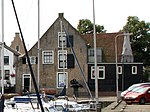MV Greenpeace
1959 shipsIMO numbersIndividual ship or boat stubsMMSI NumberMuseum ships in the Netherlands ... and 2 more
Ships built in the NetherlandsShips of Greenpeace

The MV Greenpeace (formerly (1959–1977) and since 2002 known as the Elbe) was a Greenpeace ship built in 1959 as an oceangoing tug/salvage vessel. She was purchased by Greenpeace in 1985 from the Maryland Pilotage Company, the vessel then being named MV Maryland, and transferred back to the Netherlands to be refitted with modern equipment before being recommissioned. She took over from the first Rainbow Warrior, which had been sunk in 1985 by French commandos. In 2001 she was replaced by the MV Esperanza.
Excerpt from the Wikipedia article MV Greenpeace (License: CC BY-SA 3.0, Authors, Images).MV Greenpeace
Govert van Wijnkade,
Geographical coordinates (GPS) Address Nearby Places Show on map
Geographical coordinates (GPS)
| Latitude | Longitude |
|---|---|
| N 51.916617 ° | E 4.24698 ° |
Address
Govert van Wijnkade 44
3144 EG
South Holland, Netherlands
Open on Google Maps










